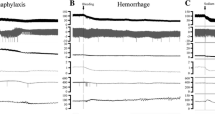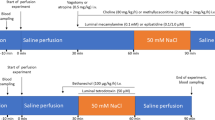Abstract
Antigen challenge of jejunal epithelium from rats sensitized to egg albumin induces an active Cl− secretory process secondary to release of mucosal mast cell mediators. The present study was designed to define the relative role of these mast cell mediators and the enteric nervous system in the transport abnormalities associated with intestinal anaphylaxis. Net ion transport of stripped jejural tissue from sensitized and sham-treated animals was studied in Ussing chambers. The Cl− secretory response induced by egg albumin during intestinal anaphylaxis was similar to that after addition of 5-hydroxytryptamine (5-HT), histamine, and prostaglandins D2 and E2 to jejunal tissue. Cinanserin, a 5-HT2-receptor antagonist, virtually abolished the response to 5-HT and totally abolished the response to egg albumin. Methysergide, a 5-HT1-receptor antagonist had no effect on either response. Indomethacin, an inhibitor of prostaglandin synthesis, significantly inhibited the 5-HT and egg albumin response. Diphenhydramine, an H1-receptor antagonist and cimetidine, an H2-receptor antagonist both significantly inhibited the histamine response but neither altered the response to egg albumin. Atropine, an anticholinergic, and tetrodotoxin, a nerve blocker, did not inhibit the antigen induced anaphylactic response. These results indicate that 5-HT, acting through 5-HT2 receptors is largely responsible for the transport abnormalities seen in intestinal anaphylaxis induced by egg albumin while prostaglandins appear to play a partial role. The findings do not support a role for the enteric nervous system for the egg albumin induced changes in Cl− secretion.
Similar content being viewed by others
References
M. H. Perdue, M. Chung and D. G. Gall,Effect of intestinal anaphylaxis on gut function in the rat. Gastroenterology86, 391–397 (1984).
M. H. Perdue and D. G. Gall,Intestinal anaphylaxis in the rat: jejunal response to in vitro antigen exposure. Am. J. Physiol.250, G427-G431 (1986).
M. K. Patrick, I. J. Dunn, A. Buret, H. R. P. Miller, J. F. Huntley, S. Gibson and D. G. Gall,Mast cell protease release and mucosal ultrastructure during intestinal anaphylaxis in the rat. Gastroenterology94, 1–9 (1988).
M. H. Perdue and D. G. Gall,Transport abnormalities during intestinal anaphylaxis in the rat: effect of antiallergic agents. J. Allergy Clin. Immunol.76, 498–503 (1985).
P. C. Ho, R. A. Lewis, K. F. Austen and R. P. Orange,Comprehensive Immunology, pp. 179–228, Plenum, New York 1979.
J. Hardcastle, P. T. Hardcastle and J. S. Redfern,Action of 5-hydroxytryptamine on intestinal ion transport in the rat. J. Physiol.320, 41–55 (1981).
M. H. Perdue and D. G. Gall,Rat jejunal mucosal response to histamine and anti-histamine in vitro. Comparison with antigen-induced changes during intestinal anaphylaxis. Agents and Actions19, 5–9 (1986).
M. Field, M. W. Musch, R. L. Miller and E. J. Goetzl,Regulation of epithelial electrolyte transport by metabolites of arachidonic acid. J. Allergy Clin. Immunol.74, 382–385 (1984).
D. Branski, M. Eran, P. Sharon, E. Gross-Kieselstein, J. Weidenfeld and S. Freier,Rise of prostanoids in rat small intestinal mucosa following intestinal protein hypersensitivity. Pediatr. Res.21, 414–416 (1987).
G. A. Castro, Y. Harari and D. Russell,Mediators of anaphylaxis-induced ion transport changes in small intestine. Am. J. Physiol.253, G540-G548 (1987).
H. J. Cooke and H. V. Carey,Pharmacological analysis of 5-hydroxytryptamine actions on guinea-pig ileal mucosa. Eur. J. Pharmacol.111, 329–337 (1985).
M. H. Perdue, J. F. Forstner, N. W. Roomi and D. G. Gall,Epithelial response to intestinal anaphylaxis in rats: goblet cell secretion and enterocyte damage. Am. J. Physiol.247, G632-G637 (1984).
Z. Ovary,CIOMS Symposium, pp. 259–279. Blackwell Scientific, Oxford 1964.
T. W. Clarkson and S. R. Toole,Measurement of short-circuit current across the intestinal wall of the rat. Am. J. Physiol.207, 415–421 (1964).
L.-E. Arvidsson, U. Hacksell and R. A. Glennon,Progress in Drug Research, vol. 30, pp. 365–472, Birkhauser-Verlag, Basel 1986.
J. E. Leyson and P. A. J. Janssen,Receptor binding profile of R41 468, a novel antagonist at 5-HT 2 receptors. Life Science28, 1015–1022 (1981).
J. Hardcastle and P. T. Hardcastle,The secretory actions of histamine in rat small intestine. J. Physiol.388, 521–532 (1987).
E. Beubler, K. Bukhave and J. Rask-Madsen,Significance of calcium for the prostaglandin E 2 -mediated secretory response to 5-hydroxytryptamine in the small intestine of the rat in vivo. Gastroenterology90, 1972–1977 (1986).
T. Branchek, M. Kates and M. D. Gershon,Enteric receptors for 5-hydroxytryptamine. Brain Res.324, 107–118 (1984).
T. S. Gaginella, T. J. Rimele and M. Wietecha,Studies on rat intestinal epithelial cell receptors for serotonin and opiates. J. Physiol. (Lond.)335, 101–111 (1983).
M. Donowitz, N. Asarkof and G. Pike,Calcium dependence of serotonin-induced changes in rabbit ileal electrolyte transport. J. Clin. Invest.66, 341–352 (1980).
J. Hardcastle, P. T. Hardcastle and J. M. Noble,The involvement of calcium in the intestinal response to secretagogues in the rat. J. Physiol.355, 465–478 (1984).
F. L. Pearce,Calcium and mast cell activation. Br. J. Clin. Pharmc.20, 267S-274S (1985).
A. W. Baird, R. R. A. Coombs, P. McLaughland and A. W. Cuthbert,Immediate hypersensitivity reactions to cow's milk protein in isolated epithelium from ileum of milk-drinking guinea-pigs: comparison with colonic epithelium. Int. Arch. Allergy Appl. Immunol.75, 255–263 (1984).
A. W. Cuthbert, P. McLaughlan and R. R. A. Coombs,Immediate hypersensitivity reaction to β-lactoglobulin in the epithelium lining the colon of guinea pigs fed cow's milk. Int. Arch. Allergy Appl. Immunol.72, 34–40 (1983).
H. R. P. Miller,The protective mucosal response against gastrointestinal nematodes in ruminants and laboratory animals. Veterinary Immunol. Immunopath.6, 167–259 (1984).
Author information
Authors and Affiliations
Rights and permissions
About this article
Cite this article
Catto-Smith, A.G., Patrick, M.K., Hardin, J.A. et al. Intestinal anaphylaxis in the rat: Mediators responsible for the ion transport abnormalities. Agents and Actions 28, 185–191 (1989). https://doi.org/10.1007/BF01967399
Received:
Accepted:
Issue Date:
DOI: https://doi.org/10.1007/BF01967399




